Intro to Windows NT
This document is meant as an intro to NT4 on workstations for advanced computer users.
It is made as a short technical comparision with Windows 3.
Basic NT info
- NT is an operating system for PC. It’s able to run almost all DOS, Windows 3, and
Win 32 applications.
- Previous versions: NT 3.51 Workstation and 3.51 Server
- Most recent versions from 1996: NT 4 Workstation and NT 4 Server.
- As the names imply, the Server version is better suited as a network server and the
Workstation version is better suited as a standalone PC or network client. But the
differences are subtle.
- NT is mostly used on PC computers, but it’s ported to the DEC Alpha RISC processor,
and may be ported to other platforms in the future.
- A new installation of NT 4 takes about 150 MB, but at least 300 MB hard disk space
should be available for the NT system.
- One alternative to NT is Windows 95, but it has lower stability and security.
- One other alternative to NT is OS/2, but it can’t run any of the new 32 bit Windows
applications. Despite that, OS/2 is a stable system, suitable for organisations that
don’t need the latest Windows programs.
Memory
model
PCs using DOS or Windows 3 are using an old memory model which may cause trouble. DOS
is limited to addressing 640 kB (fig 1).
Windows 3 and 95 can access more memory after a rather complicated shuffling of memory.
Those systems start on DOS mode, then the CPU switches to "protected
mode", accessing more memory and "virtual machine" mode. This usage
of memory blocks, and the lack of protected memory areas for applications, leads to a
greater risk for system crashes.
The practical effective memory limit for Windows 3 seems to be about 16 MB. It is
claimed that Windows 95 does not handle memory efficiently above about 40 MB, but I cannot
confirm that. (fig 2).
Windows NT – as well as OS/2, Linux and Mac OS – has a flat addressing of the
RAM memory, which reduces trouble (fig 3). Individual programs under NT run in a protected
memory area, so that they can't cause a system crash.
Memory map, Intel CPU in standard mode
under old DOS |
Intel CPU in protected mode under
Windows 3 or Win 95 |
Intel CPU in protected mode under
operating system with flat memory model, e.g. NT, OS/2 or Linux |
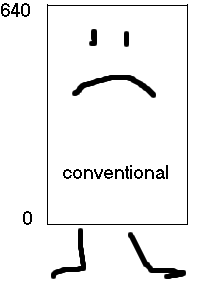 |
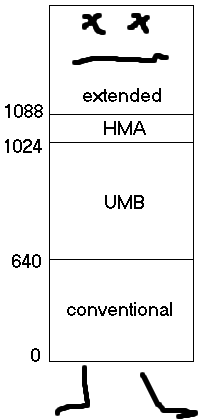 |
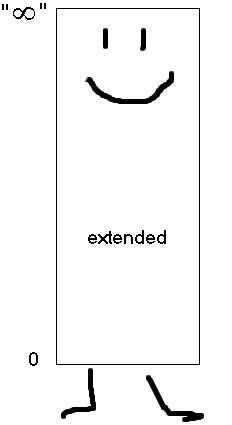 |
Technical info
Requires at least a 386 with 16 MB RAM. Recommended for Intel Pentium or compatible CPU
with at least 32 MB RAM. Preferably 48 or 64 MB RAM if you will use several large
applications simultaneously.
NT uses a flat memory model addressing up to 4 GB RAM. NT can theoretically use a
maximum addressable hard disk space of 16 exabyte (16x10 exp 18), i.e. 16 000 000 000
gigabyte.
NT uses preemptive multitasking. That means the
OS has more control over each process. It is impossible for an application to take over
and lock the whole system, but this also means a certain system overhead. If one
application crashes, it can be terminated with CTRL-ALT-DEL without crashing the
system.
Compare with Novell Netware, which usually uses cooperative multitasking. That
is more efficient than preemptive multitasking but a bad NLM (Netware Loadable Module) may
crash the whole system.
System setup is saved in the register, which can be accessed by REGEDIT and REGEDT32.
Installed 32 bit applications can be removed from the Control panel, which you reach from
Start | Settings.
NT uses HAL, a "hardware abstraction layer", between hardware
and system code. Thus it’s relatively easy to port NT to other processors. Below is
an illustration of how that works.
user (yes, that's you) |
applications |
drivers |
NT operating system kernel |
HAL |
hardware |
NT 4 uses the same good system for switchable character sets and
keyboards, as Windows 95. It’s e.g. easy to produce text in Russian mixed with Latin
alphabet text. It works with different code tables for Cyrillic characters.
Accounts
After a normal new NT installation, 2 accounts are created on the local
machine, Administrator and Guest. The Guest account is disabled by default and the
Administrator account will prompt for a password during the first logon.
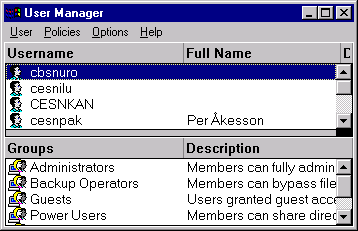
In a network installation, each user must be defined, before the computer can be used.
In this user definition, username and password should be set as the same as in the
network. If the password is entered here, the user should be present and do it. If the
password field is left blank here, the user can enter it during the first login. But then
the user must be informed how that is done.
Novell Netware
Novell 3 servers do not support long file names without an extra NLM installed. In such
a case, documents should be given a name of max 8 characters.
The Start menu
The appearance of the Start menu can be customised by right-clicking on Start, followed
by Open, Open all users, or Explore all users. This is mentioned below, under
security.
Important keyboard commands and Help
These work in almost the same way under Windows 3.11 and Windows 95. Any user who is
not used to Windows multitasking should always have the taskbar visible. It is very easy
to by mistake start e.g. Word twice, working on the same document. That can be a quick way
to destroy your data.
Ctrl-Esc show task bar or task list
Alt-Esc move active task to background
Alt-Tab switch between tasks
Alt-Enter switch a DOS session between window and full screen
Ctrl-Alt-Del shows task list and enables terminating bad processes
If you are not used to Windows 95 or NT, you should know that several functions can be
reached by right-clicking the mouse. Try it yourself, and you will learn.
If you need help, try the built-in help system. To find general help on NT, click on
Start, Help, and Contents. In various applications or dialogs, you can press F1 or open
any menus marked Help or ?.
File systems
Windows NT has 2 built-in file managers: This Computer and Explorer. It’s
important to know how they work.
If you want, you can create a document directly on the desktop. All you need is to
right-click the mouse. The file is then stored in directory
C:\WINNT\PROFILES\username\DESKTOP. This is not very obvious, but it’s similar in
Windows 95.
On the desktop you can see both "shortcuts" and icons
representing real files. You should be careful about dragging the latter to the trashcan.
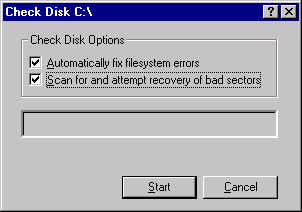
To check the status of your hard disk, open My Computer, right-click on drive C: then
choose Properties and Tools. Finally choose Error checking. It‘s a good habit to do
this check every week or so.
Windows NT supports 2 file systems, FAT and NTFS. When you use FAT, you actually use
something called VFAT. That is an extension to the FAT system, allowing for long file
names. The same system as in Windows 95. It works fine until you use an old 16 bit Windows
or DOS file utility. Then the file name is truncated. Therefore you should always use
document names with distinct beginnings, even when you use long document names.
Files deleted with a 32 bit program are temporarily stored in the Recycle bin, which is
more convenient than the old UNDELETE command.
If you run out of hard disk space, NT offers a possibility to compress the disk. This
is similar to Stacker, DoubleDisk, DriveSpace, etc. I do not recommend compressing hard
disks. It’s slower, and depends on a special driver. Also, you can’t access that
drive directly from a normal boot disk.
If you need high security for local files on a PC, I recommend the NTFS file system.
When you use NTFS, you can hide or lock certain files or directories for certain
users.
If the previous file system was FAT, NT has a convert command. A conversion can be made
without loss of data. Thus an existing NT installation can be converted to NT later.
NTFS has a built-in function for hotfix, similar to the Novell Netware system. Bad
sectors on a hard disk are marked out automatically, protecting data written to disk. For
most users, the FAT file system gives a good enough security.
If you use the FAT file system, you can alternatively boot NT, Windows 95 (if that is
also installed) and DOS, on the same partition, thanks to the Microsoft menu system.
NT, as well as Windows 3.11 and Windows 95, supports the Workgroup function, where you
can choose to share directories on your hard disk with others.
NT Security
System password
If you enter the computer's BIOS setup, you can configure your computer so that a
password must be entered before accessing the computer, even if you boot with a DOS
diskette. Such a protection can however be disabled by opening the computer case.
NT password
NT can never be started without logging on. Without an account and password, nobody can
enter the system without a boot diskette. This is an important improvement to Windows 3 or
Windows 95.
Modifying desktop and Start menu
You can modify the Start menu by right-clicking the Start button. Those
changes will then apply only to the account, that you are logged in to.
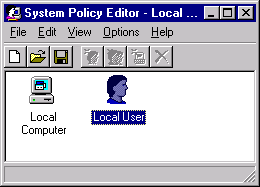
Except for the security offered by the NTFS file system, you can also use the Policy
editor, to hide certain menu choices for certain users. The Policy editor is not part of a
normal NT Workstation installation, but I mention it here as an example of possible
security functions. The Policy editor is mainly for a network where the server is running
NT Server, but it can be used also on NT Workstation. The first time you start Poledit, go
to Options and load a template. The Common template is usually enough. If you then choose
Open registry, any policy changes will be saved to the local machine, for the particular
account you have logged on. Then save your changes. One example: You can hide Run, DOS
Prompt and Explorer from the Start menu if the computer is logged on by Guest.
Encryption
Word and other word processors offer a built-in system for encryption. You reach it
under the Save as menu.
Summary
These kinds of security offer only a light protection. Confidential data should be
saved on a network server or on removable media.
NT Advantages
NT has higher stability and security than Windows 3 or Windows 95. NT is more resistant
to viruses; there are very few viruses that can harm NT.
NT Disadvantages
New hardware is required, new installation required, fewer available drivers than on
Windows 95, some DOS programs may not work, some Win 32 programs may work on Win 95 but
not on Win NT.
Windows networking
This is sometimes called the poor man’s network. To enable it, you open the
Control panel and choose Network. You must have a network adapter installed.
After that installation, you right-click on a resource and choose Share. The shared
resource will be displayed with a little hand underneath.
With this service, you can use Workgroups. That is a way to connect to other computers
running NT, Windows 3.11 or Windows 95, not even needing a dedicated network server. In
this service, it’s possible to share local directories or resources, such as printer,
modem and CD drive, with others. This is suitable for small networks, with up to 5 or 10
computers. Larger networks usually have a Novell, NT or Unix server.
Further reading
To really learn NT, you may need one of the official NT training kits from Microsoft.

Per Åkesson, May, 1997
rev 1999 |